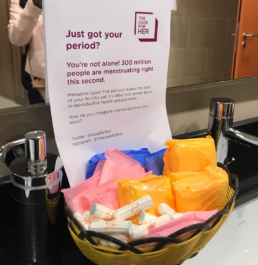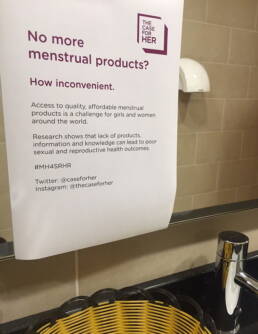The menstrual cycle, or the process the female body undergoes to prepare for pregnancy and reproduction, begins with menstruation. From the day bleeding begins, one can calculate when the ovulatory and luteal phase will likely occur, i.e. when pregnancy is most likely to happen. If a pregnancy does not occur, the cycle begins anew — announced by menstruation. Menarche and menopause mark the beginning and end of a women’s fertility.
Thus, menstruation is integral to family planning and reproductive health. By teaching girls and women to be body literate and to understand their menstrual cycle, we could prevent misconceptions about the female body and family planning. By enabling them to better manage their menstruation, we could improve reproductive health and family planning outcomes.

Yet, there was little talk about menstruation at the 2018 International Conference on Family Planning (ICFP), in November in Kigali, Rwanda.
As ICFP was getting underway, we decided to do something about it. On the first full day of the conference, we placed baskets of tampons and sanitary pads in each of the women’s bathrooms and one of the men’s (male awareness is essential to overcoming stigma) around the Kigali Convention Center.
The baskets were paired with signs designed to get conference participants thinking about the ways that menstrual health and hygiene programs share the same goals as programs for sexual and reproductive health and rights.
Both work to ensure greater access to products and services and to improve behaviors for better health and greater empowerment of girls and women.
One example of how these programs overlap is contraceptive-induced bleeding changes. The largest reason for contraceptive discontinuation in the first year of use is side effects and health concerns, of which bleeding changes are the most significant. As we heard at ICFP, most contraceptive methods cause some change in bleeding patterns, with methods like implants and injectables causing intermittent bleeding and spotting that can last for several months. Reassurance from a provider that this type of bleeding change is to be expected can only go so far to making it okay, especially if the woman cannot afford a continued supply of comfortable, functional menstrual absorbents. Can you imagine spotting everyday if you did not have access to or could not afford panty liners?
Was there any interest in menstruation at the conference?
Oh yes, did people grab those products! Over 500 individual tampons and pads were picked up by the approximately 4,000 conference participants in less than two days. Even the menstrual absorbents that we put in the men’s room disappeared — three times!
On the last day of the 3-day conference, we changed up the message. We could not keep up with the rate at which the menstrual products were stocking out. We hung new signs.

No more menstrual products? Tough luck. That is the reality that women and girls around the world face.
Menstrual hygiene and family planning interventions share many similarities that offer opportunities for collaboration and learning — some of which are just beginning to be recognized. On some of our signs we pointed out that we had not been able to offer “long-acting” menstrual products, like menstrual cups and reusable pads. When it comes to both family planning and menstrual hygiene products, issues like quality, affordability, access, and choice are paramount. Stock-outs are common. Choice, particularly for “long-acting” products, is often limited by affordability and access. And there is a need for quality standards to ensure products are safe and effective for the women and girls who use them.
As women’s periods don’t stop in emergencies, they certainly do not stop for a conference and we saw people chatting around the baskets and continuing the conversations outside.
This guerrilla activism started quite the conversation, but we cannot take all the credit for the menstrual conversations at the ICFP. There were a few other groups, presentations, and posters that highlighted similar issues.
- Kasha, an e-commerce enterprise located in Kigali, presented results from their first two years of operating an online/offline platform from which clients can confidentially order women’s health and personal care products such as contraceptives, menstrual absorbents, HIV self-test kits, soaps, lotions, and make-up, and get the products discretely delivered to their location of choice.
- ZanaAfrica Foundation, a Kenya-based group, talked about building demand and providing reproductive health education via their branded sanitary pad, Nia, as part of panel on using narrative to increase demand among adolescents.
- The AmplifyChange PitchFest included several pitches that integrated menstrual health — including one of the winning pitches by Les Ailes de Coeur, which will lead an advocacy campaign to include menstrual hygiene management within the reproductive health programming of the Ministry of Health in the Democratic Republic of Congo.
This was a vast improvement over past ICFPs and we hope that the next ICFP, to be held in 2020, will have even more examples of holistic reproductive health and family planning programs that incorporate menstrual health and hygiene. Because it’s true, without ovulation and the shedding of the uterine lining there is no need for family planning, nor any new babies.
This post originally appeared on the Medium page of Lucy Wilson, an independent consultant in reproductive health.
-
Wendy Andersonhttps://thecaseforher.com/blog/author/wendy/
-
Wendy Andersonhttps://thecaseforher.com/blog/author/wendy/
-
Wendy Andersonhttps://thecaseforher.com/blog/author/wendy/
-
Wendy Andersonhttps://thecaseforher.com/blog/author/wendy/
Co-founder of The Case for Her
-
Gerda Larssonhttps://thecaseforher.com/blog/author/gerda/
-
Gerda Larssonhttps://thecaseforher.com/blog/author/gerda/
-
Gerda Larssonhttps://thecaseforher.com/blog/author/gerda/
-
Gerda Larssonhttps://thecaseforher.com/blog/author/gerda/




